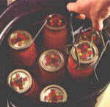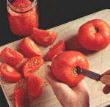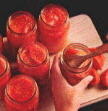1 Answer
<font size="-1" face="verdana,arial,helvetica">Traditionally, canning tomatoes has usually been done by using the hot water bath canner method. Recently, however, more people are finding that canning tomatoes in a pressure canner will result in higher quality and give you a more nutritious product.
Pressure canning is also required for many canned tomato combination products because the</font> <font size="-1" color="#0000FF" face="verdana,arial,helvetica">pH value</font> <font size="-1" face="verdana,arial,helvetica">is above 4.6 which is a low acidic food. Tomatoes themselves fall close to the low acid level, just slightly above 4.6 and when mixed with meat for sauces or with vegetables like peppers or zucchini, which are a low acidic food it raises the pH value above 4.6 and must be processed by pressure canning to insure food safety. Foods that have a pH value of 4.6, or lower, may be processed in a boiling water bath canner.
When canning tomatoes by themselves, it is recommended that acid should be added to lower the pH level. This can be done by adding 1 tablespoon of lemon juice or 1/4 teaspoon citric acid per pint of product. For quarts, add 2 tablespoons of lemon juice or 1/2 teaspoon citric acid. This may be done by adding directly to jars before filling.</font>
<center><font size="-2" face="verdana,arial,helvetica"><font color="#FF0000">To Recipes</font>
<font size="-2" color="#000000" face="verdana,arial,helvetica">Whole Tomatoes</font> | <font size="-2" color="#000000" face="verdana,arial,helvetica">Crushed</font> | <font size="-2" color="#000000" face="verdana,arial,helvetica">Without Liquid</font> | <font size="-2" color="#000000" face="verdana,arial,helvetica">With Zucchini</font>
<font size="-2" color="#000000" face="verdana,arial,helvetica">Stewed Tomatoes</font> | <font size="-2" color="#000000" face="verdana,arial,helvetica">Seasoned</font> | <font size="-2" color="#000000" face="verdana,arial,helvetica">Mexican Chile Pepper Sauce</font>
<font size="-2" color="#000000" face="verdana,arial,helvetica">Chile Salsa</font> | <font size="-2" color="#000000" face="verdana,arial,helvetica">Chili Sauce</font> | <font size="-2" color="#000000" face="verdana,arial,helvetica">Spaghetti Sauce</font></font>
</center>
<font size="-1" face="verdana,arial,helvetica">Jars and Lids
Lids
Place jar lids in a small sauce pan filled with water and boil gently for 10 minutes before using. Do this before you need to place them on jars. Leave in hot water and remove as needed.
Jars
Sometimes recipes will say that it is not necessary to sterilize jars if they are to be packed with hot food. However, to be safe it is always a good idea. For preparing jars, wash them in hot soapy water and rinse well. Place in a large pot of water or water bath canner, and boil gently for 10 minutes. Leave in hot water until needed. Then remove a few jars at a time and place upside down to drain. They are ready to use in less than a minute.</font>
<center><font size="-1" face="verdana,arial,helvetica">Processing Methods</font></center>
<font size="-1" face="verdana,arial,helvetica">Boiling Water Bath Canner</font>
<font size="-1" face="verdana,arial,helvetica">Fill the kettle with the appropriate amount of hot water and begin heating it on the range. The water bath canner requires 1 to 2 inches of water above the tops of jars. This can be difficult to determine before the filled jars are in place but after a batch or two you will learn how much water you you have to add. It is always a good idea to have an extra small pot of water heating just in case.
idea to have an extra small pot of water heating just in case.
Place jars on rack immediately after packing. Lower filled rack into canner. Jars should be covered by 1 to 2 inches of water. Add additional boiling water if needed. If you add more water, pour between jars and not directly on them (this is where the extra pot of heated water comes in handy). Cover pot with lid. When the water comes to a rolling boil, start to count the processing time. Reduce heat slightly and boil gently for the time recommended for the food being processed. When the cooking time is up, remove jars at once and place on a rack or on towels away from heat and away from any draft. Keep jars separated to allow for air space.
After jars have cooled, test for seal. To do this press down on the center of the lid. The lid should be con-caved and not move when pressed. Another method is to tap the lid with the bottom of a teaspoon. If the jar is sealed correctly, it will make a high-pitched sound. If it makes a dull sound it means the lid is not sealed or possibly that food is in contact with the underside of the lid.
When completely cool, the screw bands may be removed if desired but not necessary. Be sure to label canned jars with content and processing date. Store jars in a cool dark, dry place. If there is a possibility of freezing temperatures during storage, cover with a blanket or heavy cloth. Jars may also be placed in a box and stuffed with newspaper.</font>
<center><font size="-2" face="verdana,arial,helvetica"><font color="#FF0000">To Tomato Recipes</font>
<font size="-2" color="#000000" face="verdana,arial,helvetica">Whole Tomatoes</font> | <font size="-2" color="#000000" face="verdana,arial,helvetica">Crushed</font> | <font size="-2" color="#000000" face="verdana,arial,helvetica">Without Liquid</font> | <font size="-2" color="#000000" face="verdana,arial,helvetica">With Zucchini</font>
<font size="-2" color="#000000" face="verdana,arial,helvetica">Stewed Tomatoes</font> | <font size="-2" color="#000000" face="verdana,arial,helvetica">Seasoned</font> | <font size="-2" color="#000000" face="verdana,arial,helvetica">Mexican Chile Pepper Sauce</font>
<font size="-2" color="#000000" face="verdana,arial,helvetica">Chile Salsa</font> | <font size="-2" color="#000000" face="verdana,arial,helvetica">Chili Sauce</font> | <font size="-2" color="#000000" face="verdana,arial,helvetica">Spaghetti Sauce</font></font>
<font size="-2" color="#FF0000" face="verdana,arial,helvetica">Top of Page</font>
</center>
<font size="-1" face="verdana,arial,helvetica">Pressure Canner</font>
<font size="-1" face="verdana,arial,helvetica">Follow manufactures instructions for opening and closing the pressure canner. Have 2 to 3 inches of hot water in pressure canner and stand the jars on the rack insert so they are not touching each other or the sides of the pot. Fasten lid and turn on heat. Steam, mixed with air, will start to flow from the vent and then This is about 8 to 10 minutes after the first sign of steam. As the air is driven out from the canner the steam will change from a white vapor or cloud to nearly invisible.
Start processing time when pressure has been reached or when weighted gauge begins to rock. It is then time to close the the pet-cock or regulator. Maintain a steady pressure during processing.
When processing time is up, remove the canner from heat and let the pressure return to zero without assistance. Standard heavy-walled canners take about 30 minutes when loaded with pints and about 45 minutes when loaded with quarts. Do not attempt to cool pot with cold water. This can cause liquid to escape from jars and keep lids from properly sealing. It can also cause pot warpage.
After pressure reaches zero, wait 2 minutes longer and then slowly open or remove the pet-cock or regulator. Unfasten cover and tilt the far side up so any steam remaining will escape away from you. Using a jar lifter, remove each jar and place on a dry, non-metallic surface or towel. Leave space between jars for air circulation.
After jars have cooled,</font> <font size="-1" color="#0000FF" face="verdana,arial,helvetica">test for seal</font> <font size="-1" face="verdana,arial,helvetica">and the screw bands may be removed if desired. Be sure to label canned jars with content and processing date. Store jars in a cool dark, dry place.</font>
<center><font size="-2" face="verdana,arial,helvetica"><font color="#FF0000">To Recipes</font>
<font size="-2" color="#000000" face="verdana,arial,helvetica">Whole Tomatoes</font> | <font size="-2" color="#000000" face="verdana,arial,helvetica">Crushed</font> | <font size="-2" color="#000000" face="verdana,arial,helvetica">Without Liquid</font> | <font size="-2" color="#000000" face="verdana,arial,helvetica">With Zucchini</font>
<font size="-2" color="#000000" face="verdana,arial,helvetica">Stewed Tomatoes</font> | <font size="-2" color="#000000" face="verdana,arial,helvetica">Seasoned</font> | <font size="-2" color="#000000" face="verdana,arial,helvetica">Mexican Chile Pepper Sauce</font>
<font size="-2" color="#000000" face="verdana,arial,helvetica">Chile Salsa</font> | <font size="-2" color="#000000" face="verdana,arial,helvetica">Chili Sauce</font> | <font size="-2" color="#000000" face="verdana,arial,helvetica">Spaghetti Sauce</font></font>
<font size="-2" color="#FF0000" face="verdana,arial,helvetica">Top of Page</font>
</center>
<font size="-1" face="verdana,arial,helvetica">Processing Times</font>
<font size="-1" face="verdana,arial,helvetica">Processing, or canning times, are usually for an altitude of 0 to 1000 feet. If you are canning at a higher altitude, the times will need to be increased. This is because water has a lower boiling point at higher altitudes. Because of the lower boiling temperature the processing time is increased to insure that the harmful bacteria is destroyed.
Water Bath Canner
For the Boiling Water Bath method, process an additional minute for each 1000 feet in elevation. (i.e.) 5000 feet=5 additional minutes of processing time.
Dial Gauge Pressure Canner
For pressure canning at higher altitudes the time remains the same but the pressure needs to be increased.
2000 to 4000 feet, 12 pounds pressure.
4000 to 6000 feet, 13 pounds pressure.
6000 to 8000 feet, 14 pounds pressure.</font>
<center><font size="-1" face="veranda,arial,helvetica">Recipes & Preparation</font>
</center>
<font size="-1" face="verdana,arial,helvetica">Tomatoes-Crushed
Ideal for use in soups, stews and casseroles.</font>
<font size="-1" face="verdana,arial,helvetica">Approximate Yields:
22 pounds whole tomatoes for canner load of 7 quarts.
14 pounds whole tomatoes for canner load of 9 pints.
Hot Pack</font>
<font size="-1" face="verdana,arial,helvetica">To remove skins, wash tomatoes and dip in boiling water for 30 to 60 seconds or until the skins begin to split. Then dip in cold water, slip off skins, core and remove any blemished or discolored parts. Cut into quarters.
Heat about 1 pound of the quarters quickly in a large pot. As they are added, crush cut pieces using a large wooded spoon or maeet. This will draw off some juice. Continue heating the tomatoes, stirring to prevent burning. Bring to a boil and gradually add the remaining quarters while stirring continually. These will soften with stirring and heating and will not need to be crushed Continue until all tomatoes are added. Then boil gently 5 minutes.
Packing Jars
Add</font> <font size="-1" color="#0000FF" face="verdana,arial,helvetica">lemon juice</font> <font size="-1" face="verdana,arial,helvetica">or citric acid to canning jars along with 1/2 teaspoon salt to each quart jar, if desired. Fill jars immediately with hot tomatoes, leaving ½-inch head space. Remove air bubbles. Wipe rim and screw threads and adjust lids and screw bands.
Processing Methods</font>
<font size="-1" color="#0000FF" face="verdana,arial,helvetica">Boiling Water Bath Canner</font>
- Pints 35 minutes
- Quarts 45 minutes
<font size="-1" color="#0000FF" face="verdana,arial,helvetica">Pressure Canner</font>
<font size="-1" face="verdana,arial,helvetica"><font size="-1" face="verdana,arial,helvetica">Dial Gauge Type @ 11 pounds pressure or Weighted Gauge Type @ 10 pounds pressure.</font></font>
- Pints 15 minutes
- Quarts 15 minutes
<font size="-1" face="verdana,arial,helvetica">After processing, remove jars immediately, place on a rack to cool.</font>
<font size="-1" color="#0000FF" face="verdana,arial,helvetica">Test for Seal.</font>
<font size="-1" face="verdana,arial,helvetica">Tomatoes-Whole or Halved (with liquid)
Ideal for use in soups, stews, casseroles and sauces.</font>
<font size="-1" face="verdana,arial,helvetica">Approximate Yields:
21 pounds whole tomatoes for canner load of 7 quarts.
13 pounds whole tomatoes for canner load of 9 pints.
To remove skins, wash tomatoes and dip in boiling water for 30 to 60 seconds or until the skins begin to split. Then dip in cold water, slip off skins, core and remove any blemished or discolored parts. Leave whole or cut in half.
Raw Pack
Heat water, for packing tomatoes, to a boil. Add</font> <font size="-1" color="#0000FF" face="verdana,arial,helvetica">lemon juice</font> <font size="-1" face="verdana,arial,helvetica">or citric acid to canning jars along with 1/2 teaspoon salt to each quart jar, if desired. Pack hot jars with prepared tomatoes and fill with boiling water leaving ½-inch head space. Remove air bubbles. Wipe rim and screw threads and adjust lids and screw bands.
Add</font> <font size="-1" color="#0000FF" face="verdana,arial,helvetica">lemon juice</font> <font size="-1" face="verdana,arial,helvetica">or citric acid to canning jars along with 1/2 teaspoon salt to each quart jar, if desired. Pack hot jars with prepared tomatoes and fill with boiling water leaving ½-inch head space. Remove air bubbles. Wipe rim and screw threads and adjust lids and screw bands.
Hot Pack
Place prepared tomatoes in a saucepan and cover with water. Heat to a boil and boil gently for 5 minutes. Add</font> <font size="-1" color="#0000FF" face="verdana,arial,helvetica">lemon juice</font> <font size="-1" face="verdana,arial,helvetica">or citric acid to canning jars along with 1/2 teaspoon salt to each quart jar, if desired. Pack hot jars with hot prepared tomatoes and fill with boiling water leaving ½-inch head space. Remove air bubbles. Wipe rim and screw threads and adjust lids and screw bands.
Processing Methods</font>
<font size="-1" color="#0000FF" face="verdana,arial,helvetica">Boiling Water Bath Canner</font>
- Pints 40 minutes
- Quarts 45 minutes
<font size="-1" color="#0000FF" face="verdana,arial,helvetica">Pressure Canner</font>
<font size="-1" face="verdana,arial,helvetica"><font size="-1" face="verdana,arial,helvetica">Dial Gauge Type @ 11 pounds pressure or Weighted Gauge Type @ 10 pounds pressure.</font></font>
- Pints 10 minutes
- Quarts 10 minutes
<font size="-1" face="verdana,arial,helvetica">After processing, remove jars immediately, place on a rack to cool.</font>
<font size="-1" color="#0000FF" face="verdana,arial,helvetica">Test for Seal.</font>
<font size="-1" face="verdana,arial,helvetica">Tomatoes-Whole or Halved (without liquid)
Ideal for use in soups, stews, casseroles and sauces.</font>
<font size="-1" face="verdana,arial,helvetica">Approximate Yields:
21 pounds whole tomatoes for canner load of 7 quarts.
13 pounds whole tomatoes for canner load of 9 pints.
To remove skins, wash tomatoes and dip in boiling water for 30 to 60 seconds or until the skins begin to split. Then dip in cold water, slip off skins, core and remove any blemished or discolored parts. Leave whole or cut in half.
Raw Pack
Add</font> <font size="-1" color="#0000FF" face="verdana,arial,helvetica">lemon juice</font> <font size="-1" face="verdana,arial,helvetica">or citric acid to canning jars along with 1/2 teaspoon salt to each quart jar, if desired. Pack hot jars with prepared tomatoes and press down until spaces between them fills with juice. Leave ½-inch head space. Remove air bubbles. Wipe rim and screw threads and adjust lids and screw bands.
Processing Methods</font>
<font size="-1" color="#0000FF" face="verdana,arial,helvetica">Boiling Water Bath Canner</font>
- Pints 85 minutes
- Quarts 85 minutes
<font size="-1" color="#0000FF" face="verdana,arial,helvetica">Pressure Canner</font>
<font size="-1" face="verdana,arial,helvetica"><font size="-1" face="verdana,arial,helvetica">Dial Gauge Type @ 11 pounds pressure or Weighted Gauge Type @ 10 pounds pressure.</font></font>
- Pints 25 minutes
- Quarts 25 minutes
<font size="-1" face="verdana,arial,helvetica">After processing, remove jars immediately, place on a rack to cool.</font>
<font size="-1" color="#0000FF" face="verdana,arial,helvetica">Test for Seal.</font>
<font size="-1" face="verdana,arial,helvetica">Tomatoes with Zucchini</font>
<font size="-1" face="verdana,arial,helvetica">To remove skins, wash tomatoes and dip in boiling water for 30 to 60 seconds or until the skins begin to split. Then dip in cold water, slip off skins, core and remove any blemished or discolored parts. Slice into quarters. To prepare zucchini, wash and cut into cubes or slices.
Hot Pack
Place prepared tomatoes in a saucepan, heat to a boil and simmer for 10 minutes. Add zucchini to the tomato mixture and boil gently an additional 5 minutes
Packing Jars
Add</font> <font color="#0000FF">lemon juice</font> <font size="-1" face="verdana,arial,helvetica">or citric acid to canning jars along with 1/2 teaspoon salt to each quart jar, if desired. Pack hot jars with hot prepared tomato and zucchini mixture and leaving 1-inch head space. Remove air bubbles. Wipe rims and screw threads and adjust lids and screw bands.
Processing Methods</font>
<font size="-1" color="#0000FF" face="verdana,arial,helvetica">Pressure Canner</font>
<font size="-1" face="verdana,arial,helvetica"><font size="-1" face="verdana,arial,helvetica">Dial Gauge Type @ 11 pounds pressure or Weighted Gauge Type @ 10 pounds pressure.</font></font>
- Pints 30 minutes
- Quarts 35 minutes
<font size="-1" face="verdana,arial,helvetica">After processing, remove jars immediately, place on a rack to cool.</font>
<font size="-1" color="#0000FF" face="verdana,arial,helvetica">Test for Seal.</font>
<font size="-1" face="verdana,arial,helvetica">Stewed Tomatoes</font>
<font size="-1" face="verdana,arial,helvetica">Makes about 6 pints.</font>
- 4 quarts washed, cored and chopped tomatoes
- 1/2 cup chopped onions
- 1/2 cup chopped green peppers
- 4 teaspoons celery salt
- 4 teaspoons sugar
- 1/2 teaspoon salt
<font size="-1" face="verdana,arial,helvetica">Hot Pack
Add all ingredients to a saucepan and bring to a boil. Simmer 10 minutes, stirring occasionally. Pack hot jars with hot prepared tomato mixture leaving ½-inch head space. Remove air bubbles. Wipe rim and screw threads and adjust lids and screw bands.
Processing Methods</font>
<font size="-1" color="#0000FF" face="verdana,arial,helvetica">Pressure Canner</font>
<font size="-1" face="verdana,arial,helvetica"><font size="-1" face="verdana,arial,helvetica">Dial Gauge Type @ 11 pounds pressure or Weighted Gauge Type @ 10 pounds pressure.</font></font>
- Pints 15 minutes
- Quarts 20 minutes
<font size="-1" face="verdana,arial,helvetica">After processing, remove jars immediately, place on a rack to cool.</font>
<font size="-1" color="#0000FF" face="verdana,arial,helvetica">Test for Seal.</font>
<font size="-1" face="verdana,arial,helvetica">Seasoned Tomato Sauce
Makes about 5 half-pints.</font>
- 10 pounds washed, peeled, cored and chopped tomatoes
- 3 medium onions, chopped fine
- 4 cloves fresh garlic, minced
- 1 1/2 teaspoon oregano
- 2 bay leaves
- 1 teaspoon salt
- 1 teaspoon black pepper
- 1/2 teaspoon crushed red pepper
- 1 teaspoon sugar
<font size="-1" face="verdana,arial,helvetica">Hot Pack
Add all ingredients to a saucepan and bring to a boil. Simmer 2 hours, stirring occasionally. Press mixture through a food mill and discard seeds. Return to sauce pan and cook over medium-high heat until thick, stirring frequently. Add</font> <font size="-1" color="#0000FF" face="verdana,arial,helvetica">lemon juice</font> <font size="-1" face="verdana,arial,helvetica">or citric acid to hot canning jars and pack with hot prepared tomato mixture leaving ½-inch head space. Remove air bubbles. Wipe rim and screw threads and adjust lids and screw bands.
Processing Methods</font>
<font size="-1" color="#0000FF" face="verdana,arial,helvetica">Boiling Water Bath Canner</font>
- Half-Pints 35 minutes
- Pints 35 minutes
<font size="-1" color="#0000FF" face="verdana,arial,helvetica">Pressure Canner</font>
<font size="-1" face="verdana,arial,helvetica"><font size="-1" face="verdana,arial,helvetica">Dial Gauge Type @ 11 pounds pressure or Weighted Gauge Type @ 10 pounds pressure.</font></font>
- Half-Pints 15 minutes
- Pints 15 minutes
<font size="-1" face="verdana,arial,helvetica">After processing, remove jars immediately, place on a rack to cool.</font>
<font size="-1" color="#0000FF" face="verdana,arial,helvetica">Test for Seal.</font>
<font size="-1" face="verdana,arial,helvetica">Mexican Chile Pepper Tomato Sauce
Makes about 7 quarts.</font>
- 18 pounds tomatoes
- 3 pounds chile peppers
- 3 cups onions, chopped
- 1 tablespoon oregano
- 1 tablespoon salt
- 1/2 cup vinegar
<font size="-1" face="verdana,arial,helvetica">Prepare chile peppers
It is best to use rubber gloves for handling chiles. If not, be sure to wash hands with soap and water before touching your face.
Wash chiles and dry. Make a slit on the side of each pepper for allowing steam to escape. Place in an oven for 6 to 8 minutes @ 400 degrees. You want the skins to blister. Remove and allow to cool. If you place them in a pan and cover with a damp cloth it will make peeling the chiles much easier.
When peppers are cool, peel and remove seeds and stem. Chop and set aside.
Hot Pack
To remove skins, wash tomatoes and dip in boiling water for 30 to 60 seconds or until the skins begin to split. Then dip in cold water, slip off skins, core and remove any blemished or discolored parts. Chop coarsely. Combine all ingredients place in a large sauce pan or cast iron skillet. Bring to a boil, cover and simmer gently for 10 minutes, stirring occasionally.
Pack hot jars with hot prepared tomato mixture leaving 1-inch head space. Remove air bubbles. Wipe rim and screw threads and adjust lids and screw bands.
Processing Methods</font>
<font size="-1" color="#0000FF" face="verdana,arial,helvetica">Pressure Canner</font>
<font size="-1" face="verdana,arial,helvetica"><font size="-1" face="verdana,arial,helvetica">Dial Gauge Type @ 11 pounds pressure or Weighted Gauge Type @ 10 pounds pressure.</font></font>
- Pints 20 minutes
- Quarts 25 minutes
<font size="-1" face="verdana,arial,helvetica">After processing, remove jars immediately, place on a rack to cool.</font>
<font size="-1" color="#0000FF" face="verdana,arial,helvetica">Test for Seal.</font>
| 13 years ago. Rating: 0 | |

 uncertain
uncertain
 Darci13
Darci13
 Best answer!
Best answer!




